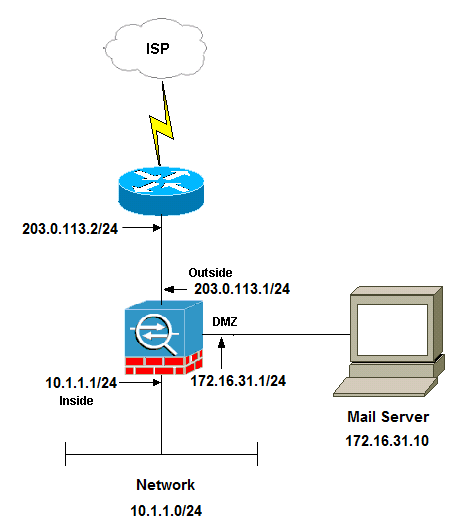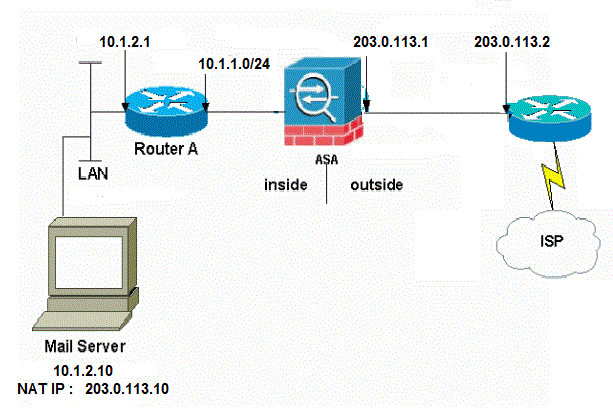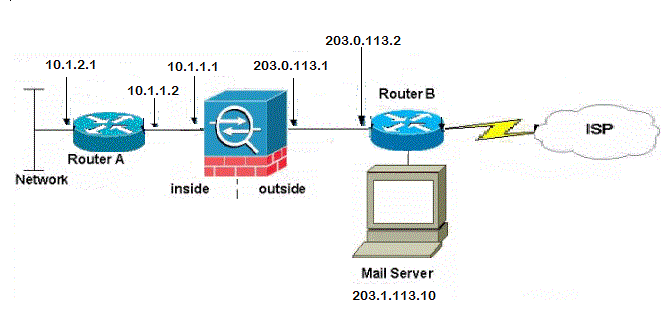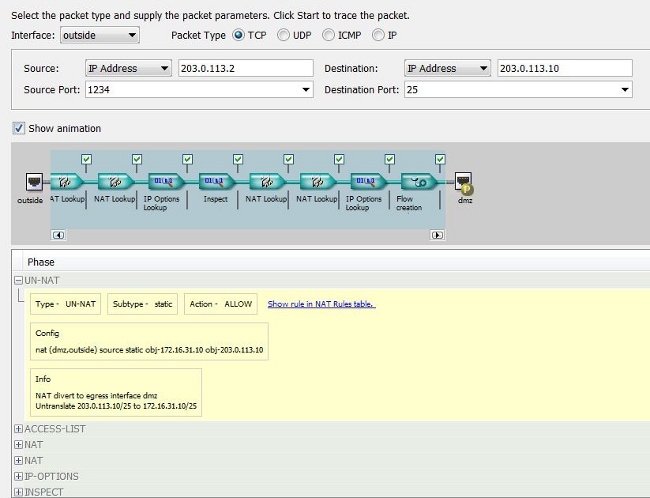Configure the ASA for SMTP Mail Server Access in DMZ, Inside, and Outside Networks
Available Languages
Contents
Introduction
This document describes how to configure a Cisco Adaptive Security Appliance (ASA) for access to a Simple Mail Transfer Protocol (SMTP) server that is located in the Demilitarized Zone (DMZ), the inside network, or the outside network.
Prerequisites
Requirements
There are no specific requirements for this document.
Components Used
The information in this document is based on these software and hardware versions:
- Cisco ASA that runs software Version 9.1 or later
- Cisco 2800C Series Router with Cisco IOS® Software Release 15.1(4)M6
The information in this document was created from the devices in a specific lab environment. All of the devices used in this document started with a cleared (default) configuration. If your network is live, make sure that you understand the potential impact of any command.
Conventions
Refer to the Cisco Technical Tips Conventions for more information on document conventions.
Configure
This section describes how to configure the ASA in order to reach the mail server in the DMZ network, the inside network, or the outside network.
Mail Server in the DMZ Network
Network Diagram
The configuration that is described in this section uses this network setup:

The network setup that is used in this example has the ASA with an inside network at 10.1.1.0/24 and an outside network at 203.0.113.0/24. The mail server with IP address 172.16.31.10 is located in the DMZ network. In order for the mail server to be accessed by the inside network, you must configure the identity Network Address Translation (NAT).
In order for the outside users to access the mail server, you must configure a static NAT and an access list, which is outside_int in this example, in order to permit the outside users to access the mail server and bind the access list to the outside interface.
ASA Configuration
This is the ASA configuration for this example:
show run
: Saved
:
ASA Version 9.1(2)
!
hostname ciscoasa
enable password 8Ry2YjIyt7RRXU24 encrypted
xlate per-session deny tcp any4 any4
xlate per-session deny tcp any4 any6
xlate per-session deny tcp any6 any4
xlate per-session deny tcp any6 any6
xlate per-session deny udp any4 any4 eq domain
xlate per-session deny udp any4 any6 eq domain
xlate per-session deny udp any6 any4 eq domain
xlate per-session deny udp any6 any6 eq domain
passwd 2KFQnbNIdI.2KYOU encrypted
names
!--- Configure the dmz interface.
interface GigabitEthernet0/0
nameif dmz
security-level 50
ip address 172.16.31.1 255.255.255.0
!
!--- Configure the outside interface.
interface GigabitEthernet0/1
nameif outside
security-level 0
ip address 203.0.113.1 255.255.255.0
!--- Configure inside interface.
interface GigabitEthernet0/2
nameif inside
security-level 100
ip address 10.1.1.1 255.255.255.0
!
boot system disk0:/asa912-k8.bin
ftp mode passive
!--- This access list allows hosts to access
!--- IP address 172.16.31.10 for the SMTP port from outside.
access-list outside_int extended permit tcp any4 host 172.16.31.10 eq smtp
object network obj1-10.1.1.0
subnet 10.1.1.0 255.255.255.0
nat (inside,outside) dynamic interface
!--- This network static does not use address translation.
!--- Inside hosts appear on the DMZ with their own addresses.
object network obj-10.1.1.0
subnet 10.1.1.0 255.255.255.0
nat (inside,dmz) static obj-10.1.1.0
!--- This Auto-NAT uses address translation.
!--- Hosts that access the mail server from the outside
!--- use the 203.0.113.10 address.
object network obj-172.16.31.10
host 172.16.31.10
nat (dmz,outside) static 203.0.113.10
access-group outside_int in interface outside
route outside 0.0.0.0 0.0.0.0 203.0.113.2 1
timeout xlate 3:00:00
timeout pat-xlate 0:00:30
timeout conn 1:00:00 half-closed 0:10:00 udp 0:02:00 icmp 0:00:02
timeout sunrpc 0:10:00 h323 0:05:00 h225 1:00:00 mgcp 0:05:00 mgcp-pat 0:05:00
timeout sip 0:30:00 sip_media 0:02:00 sip-invite 0:03:00 sip-disconnect 0:02:00
timeout sip-provisional-media 0:02:00 uauth 0:05:00 absolute
timeout tcp-proxy-reassembly 0:01:00
timeout floating-conn 0:00:00
!
class-map inspection_default
match default-inspection-traffic
!
!
policy-map type inspect dns preset_dns_map
parameters
message-length maximum client auto
message-length maximum 512
!--- The inspect esmtp command (included in the map) allows
!--- SMTP/ESMTP to inspect the application.
policy-map global_policy
class inspection_default
inspect dns maximum-length 512
inspect ftp inspect h323 h225
inspect h323 ras
inspect netbios
inspect rsh
inspect rtsp
inspect skinny
inspect esmtp
inspect sqlnet
inspect sunrpc
inspect tftp
inspect sip
inspect xdmcp
!
!--- The inspect esmtp command (included in the map) allows
!--- SMTP/ESMTP to inspect the application.
service-policy global_policy global
ESMTP TLS Configuration
If you use Transport Layer Security (TLS) encryption for email communication, then the Extended Simple Mail Transfer Protocol (ESMTP) inspection feature (enabled by default) in the ASA drops the packets. In order to allow the emails with TLS enabled, disable the ESMTP inspection feature as shown in the next example.
ciscoasa(config)#policy-map global_policy
ciscoasa(config-pmap)#class inspection_default
ciscoasa(config-pmap-c)#no inspect esmtp
ciscoasa(config-pmap-c)#exit
ciscoasa(config-pmap)#exit
Mail Server in the Inside Network
Network Diagram
The configuration that is described in this section uses this network setup:

The network setup that is used in this example has the ASA with an inside network at 10.1.1.0/24 and an outside network at 203.0.113.0/24. The mail server with the IP address 10.1.2.10 is located in the inside network.
ASA Configuration
This is the ASA configuration for this example:
ASA#show run
: Saved
:
ASA Version 9.1(2)
!
--Omitted--
!
!--- Define the IP address for the inside interface.
interface GigabitEthernet0/2
nameif inside
security-level 100
ip address 10.1.1.1 255.255.255.0
!--- Define the IP address for the outside interface.
interface GigabitEthernet0/1
nameif outside
security-level 0
ip address 203.0.113.1 255.255.255.0
!
--Omitted--
!--- Create an access list that permits Simple
!--- Mail Transfer Protocol (SMTP) traffic from anywhere
!--- to the host at 203.0.113.10 (our server). The name of this list is
!--- smtp. Add additional lines to this access list as required.
!--- Note: There is one and only one access list allowed per
!--- interface per direction, for example, inbound on the outside interface.
!--- Because of limitation, any additional lines that need placement in
!--- the access list need to be specified here. If the server
!--- in question is not SMTP, replace the occurrences of SMTP with
!--- www, DNS, POP3, or whatever else is required.
access-list smtp extended permit tcp any host 10.1.2.10 eq smtp
--Omitted--
!--- Specify that any traffic that originates inside from the
!--- 10.1.2.x network NATs (PAT) to 203.0.113.9 if
!--- such traffic passes through the outside interface.
object network obj-10.1.2.0
subnet 10.1.2.0 255.255.255.0
nat (inside,outside) dynamic 203.0.113.9
!--- Define a static translation between 10.1.2.10 on the inside and
!--- 203.0.113.10 on the outside. These are the addresses to be used by
!--- the server located inside the ASA.
object network obj-10.1.2.10
host 10.1.2.10
nat (inside,outside) static 203.0.113.10
!--- Apply the access list named smtp inbound on the outside interface.
access-group smtp in interface outside
!--- Instruct the ASA to hand any traffic destined for 10.1.2.0
!--- to the router at 10.1.1.2.
route inside 10.1.2.0 255.255.255.0 10.1.1.2 1
!--- Set the default route to 203.0.113.2.
!--- The ASA assumes that this address is a router address.
route outside 0.0.0.0 0.0.0.0 203.0.113.2 1
Mail Server in the Outside Network
Network Diagram
The configuration that is described in this section uses this network setup:

ASA Configuration
This is the ASA configuration for this example:
ASA#show run
: Saved
:
ASA Version 9.1(2)
!
--Omitted--
!--- Define the IP address for the inside interface.
interface GigabitEthernet0/2
nameif inside
security-level 100
ip address 10.1.1.1 255.255.255.0
!--- Define the IP address for the outside interface.
interface GigabitEthernet0/1
nameif outside
security-level 0
ip address 203.0.113.1 255.255.255.0
!
--Omitted--
!--- This command indicates that all addresses in the 10.1.2.x range
!--- that pass from the inside (GigabitEthernet0/2) to a corresponding global
!--- destination are done with dynamic PAT.
!--- As outbound traffic is permitted by default on the ASA, no
!--- static commands are needed.
object network obj-10.1.2.0
subnet 10.1.2.0 255.255.255.0
nat (inside,outside) dynamic interface
!--- Creates a static route for the 10.1.2.x network.
!--- The ASA forwards packets with these addresses to the router
!--- at 10.1.1.2
route inside 10.1.2.0 255.255.255.0 10.1.1.2 1
!--- Sets the default route for the ASA Firewall at 203.0.113.2
route outside 0.0.0.0 0.0.0.0 203.0.113.2 1
--Omitted--
: end
Verify
Use the information that is provided in this section in order to verify that your configuration works properly.
Mail Server in the DMZ Network
TCP Ping
The TCP ping tests a connection over TCP (the default is Internet Control Message Protocol (ICMP)). A TCP ping sends SYN packets and considers the ping successful if the destination device sends a SYN-ACK packet. You can run at most two concurrent TCP pings at a time.
Here is an example:
ciscoasa(config)# ping tcp
Interface: outside
Target IP address: 203.0.113.10
Destination port: [80] 25
Specify source? [n]: y
Source IP address: 203.0.113.2
Source port: [0] 1234
Repeat count: [5] 5
Timeout in seconds: [2] 2
Type escape sequence to abort.
Sending 5 TCP SYN requests to 203.0.113.10 port 25
from 203.0.113.2 starting port 1234, timeout is 2 seconds:
!!!!!
Success rate is 100 percent (5/5), round-trip min/avg/max = 1/1/1 ms
Connection
The ASA is a stateful Firewall, and return traffic from the mail server is allowed back through the Firewall because it matches a connection in the Firewall connection table. The traffic that matches a current connection is allowed through the Firewall without being blocked by an interface Access Control List (ACL).
In the next example, the client on the outside interface establishes a connection to the 203.0.113.10 host of the DMZ interface. This connection is made with the TCP protocol and has been idle for two seconds. The connection flags indicate the current state of this connection:
ciscoasa(config)# show conn address 172.16.31.10
1 in use, 2 most used
TCP outside 203.0.113.2:16678 dmz 172.16.31.10:25, idle 0:00:02, bytes 921, flags UIO
Logging
The ASA Firewall generates syslogs during normal operation. The syslogs range in verbosity based on the logging configuration. This output shows two syslogs that appear at level six (the informational level) and level seven (the debugging level):
ciscoasa(config)# show logging | i 172.16.31.10
%ASA-7-609001: Built local-host dmz:172.16.31.10
%ASA-6-302013: Built inbound TCP connection 11 for outside:203.0.113.2/16678
(203.0.113.2/16678) to dmz:172.16.31.10/25 (203.0.113.10/25)
The second syslog in this example indicates that the Firewall has built a connection in its connection table for this specific traffic between the client and server. If the Firewall was configured in order to block this connection attempt, or some other factor inhibited the creation of this connection (resource constraints or a possible misconfiguration), the Firewall would not generate a log that indicates that the connection was built. Instead, it would log a reason for the connection to be denied or an indication about the factor that inhibited the connection from being created.
For instance, if the ACL on the outside is not configured to permit 172.16.31.10 on port 25, then you would see this log when the traffic is denied:
%ASA-4-106100: access-list outside_int denied tcp outside/203.0.113.2(3756) ->
dmz/172.16.31.10(25) hit-cnt 5 300-second interval
This would occur when an ACL is missing or misconfigured as shown here:
access-list outside_int extended permit tcp any4 host 172.16.31.10 eq http
access-list outside_int extended deny ip any4 any4
NAT Translations (Xlate)
In order to confirm that the translations are created, you can check the Xlate (translation) table. The command show xlate, when combined with the local keyword and the internal host IP address, shows all of the entries that are present in the translation table for that host. The next output shows that there is a translation currently built for this host between the DMZ and the outside interfaces. The DMZ server IP address is translated to the 203.0.113.10 address per the previous configuration. The flags that are listed (s in this example) indicate that the translation is static.
ciscoasa(config)# show nat detail
Manual NAT Policies (Section 1)
1 (dmz) to (outside) source static obj-172.16.31.10 obj-203.0.113.10
translate_hits = 7, untranslate_hits = 6
Source - Origin: 172.16.31.10/32, Translated: 203.0.113.10/32
Auto NAT Policies (Section 2)
1 (dmz) to (outside) source static obj-172.16.31.10 203.0.113.10
translate_hits = 1, untranslate_hits = 5
Source - Origin: 172.16.31.10/32, Translated: 203.0.113.10/32
2 (inside) to (dmz) source static obj-10.1.1.0 obj-10.1.1.0
translate_hits = 0, untranslate_hits = 0
Source - Origin: 10.1.1.0/24, Translated: 10.1.1.0/24
3 (inside) to (outside) source dynamic obj1-10.1.1.0 interface
translate_hits = 0, untranslate_hits = 0
Source - Origin: 10.1.1.0/24, Translated: 203.0.113.1/24
ciscoasa(config)# show xlate
4 in use, 4 most used
Flags: D - DNS, e - extended, I - identity, i - dynamic, r - portmap,
s - static, T - twice, N - net-to-net
NAT from dmz:172.16.31.10 to outside:203.0.113.10
flags s idle 0:10:48 timeout 0:00:00
NAT from inside:10.1.1.0/24 to dmz:10.1.1.0/24
flags sI idle 79:56:17 timeout 0:00:00
NAT from dmz:172.16.31.10 to outside:203.0.113.10
flags sT idle 0:01:02 timeout 0:00:00
NAT from outside:0.0.0.0/0 to dmz:0.0.0.0/0
flags sIT idle 0:01:02 timeout 0:00:00
Mail Server in the Inside Network
TCP Ping
Here is an example TCP ping output:
ciscoasa(config)# PING TCP
Interface: outside
Target IP address: 203.0.113.10
Destination port: [80] 25
Specify source? [n]: y
Source IP address: 203.0.113.2
Source port: [0] 1234
Repeat count: [5] 5
Timeout in seconds: [2] 2
Type escape sequence to abort.
Sending 5 TCP SYN requests to 203.0.113.10 port 25
from 203.0.113.2 starting port 1234, timeout is 2 seconds:
!!!!!
Success rate is 100 percent (5/5), round-trip min/avg/max = 1/1/1 ms
Connection
Here is an example connection verification:
ciscoasa(config)# show conn address 10.1.2.10
1 in use, 2 most used
TCP outside 203.0.113.2:5672 inside 10.1.2.10:25, idle 0:00:05, bytes 871, flags UIO
Logging
Here is an example syslog:
%ASA-6-302013: Built inbound TCP connection 553 for outside:203.0.113.2/19198
(203.0.113.2/19198) to inside:10.1.2.10/25 (203.0.113.10/25)
NAT Translations (Xlate)
Here are some example show nat detail and show xlate command outputs:
ciscoasa(config)# show nat detail
Auto NAT Policies (Section 2)
1 (inside) to (outside) source static obj-10.1.2.10 203.0.113.10
translate_hits = 0, untranslate_hits = 15
Source - Origin: 10.1.2.10/32, Translated: 203.0.113.10/32
2 (inside) to (dmz) source static obj-10.1.1.0 obj-10.1.1.0
translate_hits = 0, untranslate_hits = 0
Source - Origin: 10.1.1.0/24, Translated: 10.1.1.0/24
3 (inside) to (outside) source dynamic obj1-10.1.1.0 interface
translate_hits = 0, untranslate_hits = 0
Source - Origin: 10.1.1.0/24, Translated: 203.0.113.1/24
ciscoasa(config)# show xlate
NAT from inside:10.1.2.10 to outside:203.0.113.10
flags s idle 0:00:03 timeout 0:00:00
Mail Server in the Outside Network
TCP Ping
Here is an example TCP ping output:
ciscoasa# PING TCP
Interface: inside
Target IP address: 203.1.113.10
Destination port: [80] 25
Specify source? [n]: y
Source IP address: 10.1.2.10
Source port: [0] 1234
Repeat count: [5] 5
Timeout in seconds: [2] 2
Type escape sequence to abort.
Sending 5 TCP SYN requests to 203.1.113.10 port 25
from 10.1.2.10 starting port 1234, timeout is 2 seconds:
!!!!!
Success rate is 100 percent (5/5), round-trip min/avg/max = 1/1/1 ms
Connection
Here is an example connection verification:
ciscoasa# show conn address 203.1.113.10
1 in use, 2 most used
TCP inside 10.1.2.10:13539 outside 203.1.113.10:25, idle 0:00:02, bytes 898, flags UIO
Logging
Here is an example syslog:
ciscoasa# show logging | i 203.1.113.10
%ASA-6-302013: Built outbound TCP connection 590 for outside:203.1.113.10/25
(203.1.113.10/25) to inside:10.1.2.10/1234 (203.0.113.1/1234)
NAT Translations (Xlate)
Here is an example show xlate command output:
ciscoasa# show xlate | i 10.1.2.10
TCP PAT from inside:10.1.2.10/1234 to outside:203.0.113.1/1234 flags ri idle
0:00:04 timeout 0:00:30
Troubleshoot
The ASA provides multiple tools with which to troubleshoot connectivity. If the issue persists after you verify the configuration and check the outputs that are described in the previous section, these tools and techniques might help you determine the cause of your connectivity failure.
Mail Server in the DMZ Network
Packet-Tracer
The packet tracer functionality on the ASA allows you to specify a simulated packet and view all of the various steps, checks, and functions that the Firewall goes through when it processes traffic. With this tool, it is helpful to identify an example of traffic that you believe should be allowed to pass through the Firewall, and use that five-tupple in order to simulate the traffic. In the next example, the packet tracer is used in order to simulate a connection attempt that meets these criteria:
- The simulated packet arrives on the outside.
- The protocol that is used is TCP.
- The simulated client IP address is 203.0.113.2.
- The client sends traffic that is sourced from port 1234.
- The traffic is destined to a server at IP address 203.0.113.10.
- The traffic is destined to port 25.
Here is an example packet tracer output:
packet-tracer input outside tcp 203.0.113.2 1234 203.0.113.10 25 detailed
--Omitted--
Phase: 2
Type: UN-NAT
Subtype: static
Result: ALLOW
Config:
nat (dmz,outside) source static obj-172.16.31.10 obj-203.0.113.10
Additional Information:
NAT divert to egress interface dmz
Untranslate 203.0.113.10/25 to 172.16.31.10/25
Result:
input-interface: outside
input-status: up
input-line-status: up
output-interface: dmz
output-status: up
output-line-status: up
Action: allow
Here is an example on the Cisco Adaptive Security Device Manager (ASDM):

Notice that there is no mention of the DMZ interface in the previous outputs. This is by packet tracer design. The tool tells you how the Firewall processes that type of connection attempt, which includes how it would route it and out of which interface.
Packet Capture
The ASA Firewall can capture traffic that enters or leaves its interfaces. This capture functionality is very useful because it can definitively prove whether traffic arrives at, or leaves from, a Firewall. The next example shows the configuration of two captures named capd and capout on the DMZ and outside interfaces, respectively. The capture commands use a match keyword, which allows you to be specific about the traffic that you want to capture.
For the capture capd in this example, it is indicated that you want to match the traffic seen on the DMZ interface (ingress or egress) that matches TCP host 172.16.31.10/host 203.0.113.2. In other words, you want to capture any TCP traffic that is sent from host 172.16.31.10 to host 203.0.113.2, or vice versa. The use of the match keyword allows the Firewall to capture that traffic bidirectionally. The capture command that is defined for the outside interface does not reference the internal mail server IP address because the Firewall conducts an NAT on that mail server IP address. As a result, you cannot match with that server IP address. Instead, the next example uses the word any in order to indicate that all possible IP addresses would match that condition.
After you configure the captures, you should then attempt to establish a connection again and proceed to view the captures with the show capture <capture_name> command. In this example, you can see that the outside host was able to connect to the mail server, as evident by the TCP three-way handshake that is seen in the captures:
ASA# capture capd interface dmz match tcp host 172.16.31.10 any
ASA# capture capout interface outside match tcp any host 203.0.113.10
ASA# show capture capd
3 packets captured
1: 11:31:23.432655 203.0.113.2.65281 > 172.16.31.10.25: S 780523448:
780523448(0) win 8192 <mss 1460,nop,wscale 2,nop,nop,sackOK>
2: 11:31:23.712518 172.16.31.10.25 > 203.0.113.2.65281: S 2123396067:
2123396067(0) ack 780523449 win 8192 <mss 1024,nop,nop,sackOK,nop,wscale 8>
3: 11:31:23.712884 203.0.113.2.65281 > 172.16.31.10.25. ack 2123396068
win 32768
ASA# show capture capout
3 packets captured
1: 11:31:23.432869 203.0.113.2.65281 > 203.0.113.10.25: S 1633080465:
1633080465(0) win 8192 <mss 1380,nop,wscale 2,nop,nop,sackOK>
2: 11:31:23.712472 203.0.113.10.25 > 203.0.113.2.65281: S 95714629:
95714629(0) ack 1633080466 win 8192 <mss 1024,nop,nop,sackOK,nop,wscale 8>
3: 11:31:23.712914 203.0.113.2.65281 > 203.0.113.10.25: . ack 95714630
win 32768
Mail Server in the Inside Network
Packet-Tracer
Here is an example packet tracer output:
CLI : packet-tracer input outside tcp 203.0.113.2 1234 203.0.113.10 25 detailed
--Omitted--
Phase: 2
Type: UN-NAT
Subtype: static
Result: ALLOW
Config:
object network obj-10.1.2.10
nat (inside,outside) static 203.0.113.10
Additional Information:
NAT divert to egress interface inside
Untranslate 203.0.113.10/25 to 10.1.2.10/25
Phase: 3
Type: ACCESS-LIST
Subtype: log
Result: ALLOW
Config:
access-group smtp in interface outside
access-list smtp extended permit tcp any4 host 10.1.2.10 eq smtp
Additional Information:
Forward Flow based lookup yields rule:
in id=0x77dd2c50, priority=13, domain=permit, deny=false
hits=1, user_data=0x735dc880, cs_id=0x0, use_real_addr, flags=0x0, protocol=6
src ip/id=0.0.0.0, mask=0.0.0.0, port=0, tag=0
dst ip/id=10.1.2.10, mask=255.255.255.255, port=25, tag=0, dscp=0x0
input_ifc=outside, output_ifc=any
Mail Server in the Outside Network
Packet-Tracer
Here is an example packet tracer output:
CLI : packet-tracer input inside tcp 10.1.2.10 1234 203.1.113.10 25 detailed
--Omitted--
Phase: 2
Type: ROUTE-LOOKUP
Subtype: input
Result: ALLOW
Config:
Additional Information:
in 203.1.113.0 255.255.255.0 outside
Phase: 3
Type: NAT
Subtype:
Result: ALLOW
Config:
object network obj-10.1.2.0
nat (inside,outside) dynamic interface
Additional Information:
Dynamic translate 10.1.2.10/1234 to 203.0.113.1/1234
Forward Flow based lookup yields rule:
in id=0x778b14a8, priority=6, domain=nat, deny=false
hits=11, user_data=0x778b0f48, cs_id=0x0, flags=0x0, protocol=0
src ip/id=10.1.2.0, mask=255.255.255.0, port=0, tag=0
dst ip/id=0.0.0.0, mask=0.0.0.0, port=0, tag=0, dscp=0x0
input_ifc=inside, output_ifc=outside
Related Information
Revision History
| Revision | Publish Date | Comments |
|---|---|---|
1.0 |
13-May-2015 |
Initial Release |
 Feedback
Feedback